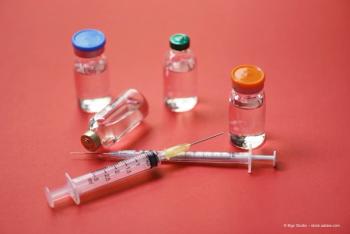
Chemotherapy for high-risk retinoblastoma: Less may be more
A Chinese study1 (
Ye and colleagues commented that while chemotherapy has increased the survival rates of patients with high-risk pathological features,2-4 underscoring the importance of postoperative adjuvant chemotherapy, the optimal number of postoperative adjuvant cycles for high-risk retinoblastoma is unknown.
“The current standard practice typically involves 6 cycles of CEV chemotherapy, a regimen adopted from other oncology fields.4,6,7 However, the general consensus is that chemotherapy should be provided in the minimal effective dosage to ensure its anticancer benefits while reducing adverse effects,” they stated.
In their randomized clinical trial, the authors compared the 5-year survival rates of the 2 chemotherapy regimens in 187 patients to assess if 3 cycles of CEV chemotherapy is noninferior to 6 cycles for treating enucleated unilateral retinoblastoma with high-risk pathological features that included massive choroidal infiltration, retrolaminar optic nerve invasion, or scleral infiltration.
The study was conducted in 2 eye centers in patients who had undergone enucleation from August 2013 and March 2024. The patients had been randomly assigned to receive either 3 (n = 94) or 6 (n = 93) cycles of CEV chemotherapy regimen after enucleation, the investigators recounted.
The primary outcome was the disease-free survival, with a noninferiority margin of 12%, and the secondary endpoints were the overall survival, safety, economic burden, and the quality of life.
Results of 3 vs 6 cycles
The patients (44.4% female) were a median age of 25.0 months. The median follow-up time was 79.0 (range, 65.5-102.5) months.
The authors reported that the 5-year disease-free survival rates were 90.4% for the 3-cycle group and 89.2% for the 6-cycle group (difference, 1.2%; 95% confidence interval, 7.5%-9.8%), which met the noninferiority criterion (P = 0.003 for noninferiority).
The patients treated with 6 cycles of CEV had more adverse events and lower quality-of-life scores. In addition, the cost of the 6 cycles was higher.
The investigators concluded, “This is the largest prospective study on adjuvant chemotherapy courses for high-risk retinoblastoma after enucleation. The results showed that 3 cycles of CEV chemotherapy are as effective as 6 in preventing metastasis and death, with fewer adverse effects and lower costs. This suggests that 3-cycle chemotherapy could become the new standard for unilateral retinoblastoma with high-risk features, potentially replacing the current 6-cycle approach.”
References
Ye H, Xue K, Zhang P, et al. Three vs 6 cycles of chemotherapy for high-risk retinoblastoma: a randomized clinical trial. JAMA. Published online October 21, 2024; doi:10.1001/jama.2024.19981
Honavar SG, Singh AD, Shields CL, et al. Postenucleation adjuvant therapy in high-risk retinoblastoma. Arch Ophthalmol. 2002;120:923-931; doi:
10.1001/archopht.120.7.923 Mustafa MM, Jamshed A, Khafaga Y, et al. Adjuvant chemotherapy with vincristine, doxorubicin, and cyclophosphamide in the treatment of postenucleation high risk retinoblastoma. J Pediatr Hematol Oncol. 1999;21:364-369. doi:
10.1097/00043426-199909000-00006 Chévez-Barrios P, Eagle RC Jr, Krailo M, et al. Study of unilateral retinoblastoma with and without histopathologic high-risk features and the role of adjuvant chemotherapy: a Children’s Oncology Group study. J Clin Oncol. 2019;37:2883-2891. doi:
10.1200/JCO.18.01808 Kaliki S, Shields CL, Shah SU, Eagle RC Jr, Shields JA, Leahey A. Postenucleation adjuvant chemotherapy with vincristine, etoposide, and carboplatin for the treatment of high-risk retinoblastoma. Arch Ophthalmol. 2011;129:1422-1427. doi:
10.1001/archophthalmol.2011.289 Luna-Fineman S, Chantada G, Alejos A, et al. Delayed enucleation with neoadjuvant chemotherapy in advanced intraocular unilateral retinoblastoma: AHOPCA II, a prospective, multi-institutional protocol in Central America. J Clin Oncol. 2019;37:2875-2882.
Sreelakshmi KV, Chandra A, Krishnakumar S, Natarajan V, Khetan V. Anterior chamber invasion in retinoblastoma: not an indication for adjuvant chemotherapy. Invest Ophthalmol Vis Sci. 2017;58:4654-4661. doi:
10.1167/iovs.17-22111
Newsletter
Keep your retina practice on the forefront—subscribe for expert analysis and emerging trends in retinal disease management.








































